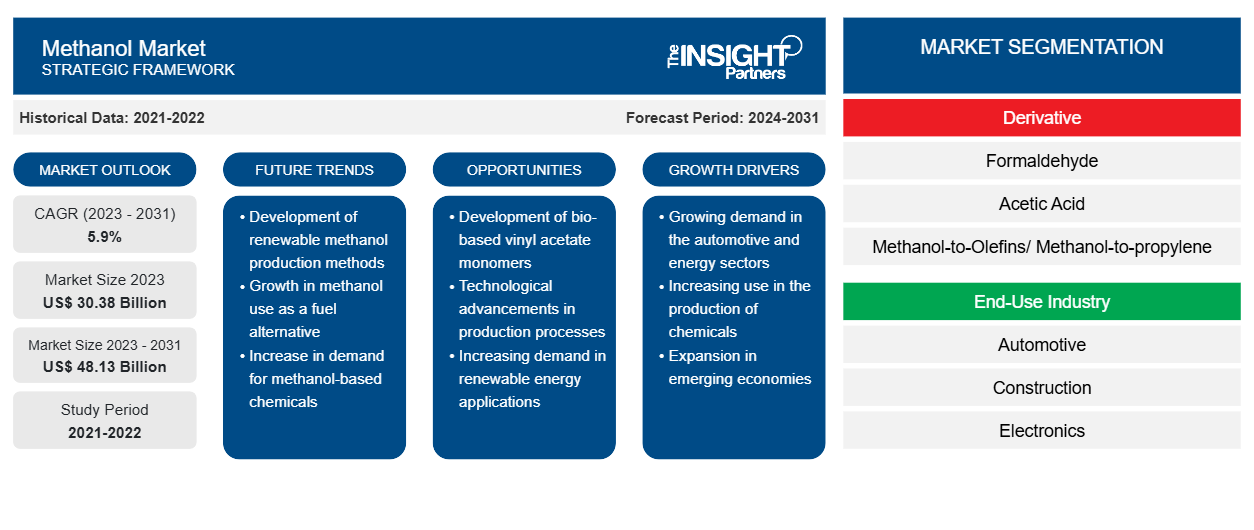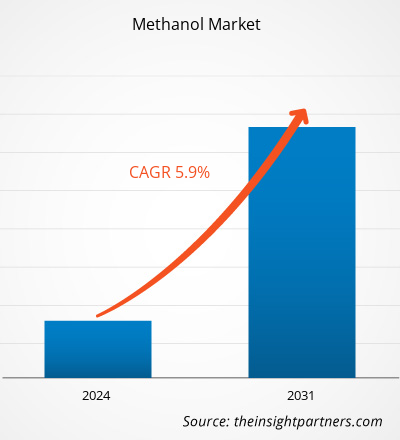Methanol Market Segments, Share, and Growth by 2031
Historic Data: 2021-2022 | Base Year: 2023 | Forecast Period: 2024-2031Methanol Market Size and Forecast (2021 - 2031), Global and Regional Share, Trend, and Growth Opportunity Analysis Report Coverage: By Derivative [Formaldehyde, Acetic Acid, Methanol-to-Olefins (MTO) / Methanol-to-propylene (MTP), Methyl Tertiary-Butyl Ether (MTBE), Methyl Methacrylate (MMA), Biodiesel, Dimethyl Ether (DME), and Others], End-Use Industry (Automotive, Construction, Electronics, Packaging, Pharmaceuticals, Paints and Coatings, and Others), and Geography
- Report Date : Feb 2026
- Report Code : TIPRE00004235
- Category : Chemicals and Materials
- Status : Data Released
- Available Report Formats :


- No. of Pages : 150
The methanol market size is projected to reach US$ 48.13 billion by 2031 from US$ 30.38 billion in 2023. The market is expected to register a CAGR of 5.9% in 2023–2031. The growing adoption of methanol as blended fuel in transportation industry is likely to remain a key methanol market trends.
Methanol Market Analysis
The rapidly increasing construction activities in different countries across the globe are driving the methanol market growth. The construction industry is a best prospect industry sector for Mexico. Mexican construction industry is growing due to the economic growth and public investment in infrastructure projects. Mexico is also moving rapidly towards green and environmentally-friendly construction activities. In the past few years, the construction sector in Indonesia has been a growth driver. The rapidly urbanizing population is driving the demand in the construction sector in the country. In addition, the growth in population and increase in government spending on infrastructure are major drivers for the construction market in Indonesia.
Methanol Market Overview
Methanol is the simplest alcohol compound utilized as an additive in industrial applications; it is a flammable, colorless, and toxic liquid chemical with a trivial smell. It is used in various industries such as, automotive, construction, electronics, packaging, pharmaceuticals, paints and coatings, and others. Methyl alcohol is used to produce formaldehyde, acetic acid, and methyl methacrylate (MMA) and is also used as a solvent in several applications. Methanol and its derivative products such as ascetic acid and formaldehyde made via chemical reactions are used as base materials in acrylic plastic; synthetic fabrics and fibers used to make clothing; adhesives, paint, and plywood used in construction; and as a chemical agent in pharmaceuticals and agrichemicals.
Customize This Report To Suit Your Requirement
You will get customization on any report - free of charge - including parts of this report, or country-level analysis, Excel Data pack, as well as avail great offers and discounts for start-ups & universities
Methanol Market: Strategic Insights

-
Get Top Key Market Trends of this report.This FREE sample will include data analysis, ranging from market trends to estimates and forecasts.
Methanol Market Drivers and Opportunities
Increasing Use of Methanol as Feedstock in Various Applications
Methanol as a key chemical building block or as a fuel, when made from renewable sources, it can help to achieve decarbonization goals. Methyl alcohol is highly used in producing plastics, adhesives, insulation materials, textiles, and food chemicals, among other chemicals and compounds. The demand for plastics is increasing due to the growing automotive sector in the world. Further, various methyl alcohol derivatives are extensively used in the pharmaceutical and healthcare industries. Hence, increasing the use of methanol in various applications in boosting the global methanol market growth.
Growing Focus towards Using Green Methanol
Green methanol is methanol that is made renewably and without polluting emissions. This chemical compound is used as a low-carbon liquid fuel and is a promising alternative to fossil fuels in areas where decarbonization is a major challenge. In recent years, sustainable and low-carbon alternatives to traditional fossil fuels have become a top priority. Thus, the growing focus on using green methanol is expected to offer more lucrative opportunities for market growth.
Methanol Market Report Segmentation Analysis
Key segments that contributed to the derivation of the methanol market analysis are derivative and end-use industry.
- Based on derivative, the methanol market is segmented into formaldehyde, acetic acid, methanol-to-olefins (MTO) / methanol-to-propylene (MTP), methyl tertiary-butyl ether (MTBE), methyl methacrylate (MMA), biodiesel, dimethyl ether (DME), and others. The formaldehyde segment held a significant market share in 2023.
- By end-use industry, the market is segmented into automotive, construction, electronics, packaging, pharmaceuticals, paints and coatings, and others. The automotive segment held a significant share of the market in 2023.
Methanol Market Share Analysis by Geography
The geographic scope of the methanol market report is mainly divided into five regions: North America, Asia Pacific, Europe, Middle East & Africa, and South & Central America.
The Asia Pacific region holds a larger share of the global market. North America is expected to register the considerable growth rate over the forecast period. Methanol is extensively used in producing various chemicals and compounds such as plastics, adhesives, insulation materials, textiles, and food chemicals. The demand for plastics is increasing and positively favoring the methanol market due to the growing automotive industry in the region. The automotive industry largely uses plastic polymers to manufacture a vehicle's interior structure and other components such as a bumper, fuel system, wheelhouse, door handles, brake pads, and under the hood components. The application of plastic components significantly reduces the vehicle's weight, increases its fuel efficiency, and meets environmental regulations regarding carbon emissions from fossil fuels.
Methanol Market Regional Insights
The regional trends and factors influencing the Methanol Market throughout the forecast period have been thoroughly explained by the analysts at The Insight Partners. This section also discusses Methanol Market segments and geography across North America, Europe, Asia Pacific, Middle East and Africa, and South and Central America.
Methanol Market Report Scope
| Report Attribute | Details |
|---|---|
| Market size in 2023 | US$ 30.38 Billion |
| Market Size by 2031 | US$ 48.13 Billion |
| Global CAGR (2023 - 2031) | 5.9% |
| Historical Data | 2021-2022 |
| Forecast period | 2024-2031 |
| Segments Covered |
By Derivative
|
| Regions and Countries Covered |
North America
|
| Market leaders and key company profiles |
|
Methanol Market Players Density: Understanding Its Impact on Business Dynamics
The Methanol Market is growing rapidly, driven by increasing end-user demand due to factors such as evolving consumer preferences, technological advancements, and greater awareness of the product's benefits. As demand rises, businesses are expanding their offerings, innovating to meet consumer needs, and capitalizing on emerging trends, which further fuels market growth.

- Get the Methanol Market top key players overview
Methanol Market News and Recent Developments
The methanol market is evaluated by gathering qualitative and quantitative data post primary and secondary research, which includes important corporate publications, association data, and databases. The following is a list of developments in the market for methanol and strategies:
- Mitsui & Co., Ltd. has agreed to acquire a 49% equity interest in Kasso MidCo ApS ("MidCo"), an affiliate of European Energy A/S ("EE", a renewable energy company headquartered in Søborg, Denmark). MidCo possesses a solar power generation and e-methanol business through Solar Park Kasso ApS ("Kasso"), its wholly owned subsidiary. (Source: MITSUI & CO., LTD., Company Website/Releases /2023)
- Jakson Green, a renewable and new energy player in India, announced today that it has won a project from National Thermal Power Corporation (NTPC) to establish a CO2-to-methanol production facility at NTPC’s Vindhyachal thermal power plant in Madhya Pradesh. (Source: PV MAGAZINE, Company Website /2023)
Methanol Market Report Coverage and Deliverables
The “Methanol Market Size and Forecast (2021–2031)” report provides a detailed analysis of the market covering below areas:
- Market size and forecast at global, regional, and country levels for all the key market segments covered under the scope
- Market dynamics such as drivers, restraints, and key opportunities
- Key future trends
- Detailed Porter’s Five Forces and SWOT analysis
- Global and regional market analysis covering key market trends, major players, regulations, and recent market developments
- Industry landscape and competition analysis covering market concentration, heat map analysis, prominent players, and recent developments
- Detailed company profiles
Habi is a seasoned Market Research Analyst with 8 years of experience specializing in the Chemicals and Materials sector, with additional expertise in the Food & Beverages and Consumer Goods industries. He is a Chemical Engineer from Vishwakarma Institute of Technology (VIT) and has developed deep domain knowledge across industrial and specialty chemicals, paints and coatings, paper and packaging, lubricants, and consumer products. Habi’s core competencies include market sizing and forecasting, competitive benchmarking, trend analysis, client engagement, report writing, and team coordination—making him adept at delivering actionable insights and supporting strategic decision-making.
- Historical Analysis (2 Years), Base Year, Forecast (7 Years) with CAGR
- PEST and SWOT Analysis
- Market Size Value / Volume - Global, Regional, Country
- Industry and Competitive Landscape
- Excel Dataset
Testimonials
The Insight Partners' SCADA System Market report is comprehensive, with valuable insights on current trends and future forecasts. The team was highly professional, responsive, and supportive throughout. We are very satisfied and highly recommend their services.
RAN KEDEM Partner, Reali Technologies LTDsI requested a report on a very specific software market and the team produced the report in a few days. The information was very relevant and well presented. I then requested some changes and additions to the report. The team was again very responsive and I got the final report in less than a week.
JEAN-HERVE JENN Chairman, Future AnalyticaWe worked with The Insight Partners for an important market study and forecast. They gave us clear insights into opportunities and risks, which helped shape our plans. Their research was easy to use and based on solid data. It helped us make smart, confident decisions. We highly recommend them.
PIYUSH NAGPAL Sr. Vice President, High Beam GlobalThe Insight Partners delivered insightful, well-structured market research with strong domain expertise. Their team was professional and responsive throughout. The user-friendly website made accessing industry reports seamless. We highly recommend them for reliable, high-quality research services
YUKIHIKO ADACHI CEO, Deep Blue, LLC.This is the first time I have purchased a market report from The Insight Partners.While I was unsure at first, I visited their web site and felt more comfortable to take the risk and purchase a market report.I am completely satisfied with the quality of the report and customer service. I had several questions and comments with the initial report, but after a couple of dialogs over email with their analyst I believe I have a report that I can use as input to our strategic planning process.Thank you so much for taking the extra time and making this a positive experience.I will definitely recommend your service to others and you will be my first call when we need further market data.
JOHN SUZUKI President and Chief Executive Officer, Board Director, BK TechnologiesI wish to appreciate your support and the professionalism you displayed in the course of attending to my request for information regarding to infectious disease IVD market in Nigeria. I appreciate your patience, your guidance, and the fact that you were willing to offer a discount, which eventually made it possible for us to close a deal. I look forward to engaging The Insight Partners in the future, all thanks to the impression you have created in me as a result of this first encounter.
DR CHIJIOKE ONYIA MANAGING DIRECTOR, PineCrest Healthcare Ltd.Reason to Buy
- Informed Decision-Making
- Understanding Market Dynamics
- Competitive Analysis
- Identifying Emerging Markets
- Customer Insights
- Market Forecasts
- Risk Mitigation
- Boosting Operational Efficiency
- Strategic Planning
- Investment Justification
- Tracking Industry Innovations
- Aligning with Regulatory Trends




















 Get Free Sample For
Get Free Sample For